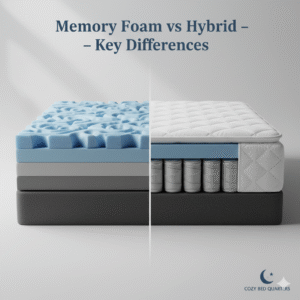When Did Bedding Ceremonies End? History, Significance, and Modern Connections
If you’re wondering when did bedding ceremonies end, the short answer is: they steadily disappeared through the late 1800s and had largely vanished by the early 1900s as privacy norms and marriage laws evolved. Today, we echo the spirit of the tradition by preparing restful sleep spaces with cleaner mattresses, thoughtful bedroom design, and eco-conscious sheets.
Key Takeaways: when did bedding ceremonies end
- Communal ritual: Bedding ceremonies publicly acknowledged marriage with songs, blessings, and playful escorting to bed.
- Timeline: The clearest answer to when did bedding ceremonies end is that they faded in the late 1800s and were rare by the early 20th century.
- Why they faded: Rising modesty, urban living, and formal marriage documentation reduced the need for public rituals.
- Modern echoes: We still “prepare the bed” via mattress hygiene, bedroom layout, and sustainable bedding choices.
Origins: Public Blessing and Proof of the Union
Answer first: Bedding ceremonies emerged to publicly bless and legitimize a new marriage. In medieval Europe, marriage was a social contract; kin and neighbors participated by escorting the couple to bed, offering prayers, music, or sweet wine, and wishing fertility and prosperity.
While customs varied by place and class, the common thread was communal acknowledgment. Some regions emphasized religious prayers; others leaned into songs or teasing. Either way, the bed became a stage for hopes of harmony, children, and good fortune.

When Did Bedding Ceremonies End? The Fast Timeline
Answer first: The practice unraveled across the 19th century and, for most communities, effectively ended by the early 20th century. Three forces drove the change:
- Modesty: The Victorian emphasis on privacy made public witnessing feel improper.
- Urban homes: Smaller, private dwellings reduced the space for crowds and spectacle.
- Law & records: Civil registration and church documentation replaced the need for communal proof.
By the 1910s, the answer to when did bedding ceremonies end was, for most regions, “they’re gone,” surviving only as memory or heritage re-enactment.

Then vs. Now: What Changed and What Stayed
Answer first: The crowd left the room, but the intention stayed. We still prepare the bed; we just do it privately with a focus on comfort, cleanliness, and wellness.
| Aspect | Then (1800s) | Now (2025) |
|---|---|---|
| Community Role | Neighbors witnessed and blessed the union. | Private gestures; symbolic touches only. |
| Symbolism | Fertility, prosperity, divine favor. | Comfort, intimacy, sleep wellness. |
| Setting | Public escort to the marriage bed. | Decorated suites and personal traditions. |
From Public Ritual to Private Hygiene
Answer first: The modern version of “preparing the bed” is hygienic upkeep and thoughtful bedding choices. Clean mattresses, breathable fabrics, and sustainable bedding preserve the freshness once symbolized by the ceremony.
For step-by-step cleaning guidance, consult the Sleep Foundation’s mattress cleaning guide and Better Homes & Gardens’ how-to; for sleep-health context, see the CDC’s overview of sleep. These sources align on basics: strip bedding, vacuum, spot-clean gently, deodorize with baking soda, and prevent future mess with a protector.
DIY Mattress Care (Quick Checklist)
Answer first: Vacuum monthly, treat stains promptly, and keep moisture low — that’s the core of mattress hygiene.
- Vacuum regularly: Use the upholstery tool and slow passes to lift dust and debris. (See Sleep Foundation/BHG guidance.)
- Deodorize: Lightly sprinkle baking soda, let sit, then vacuum thoroughly.
- Spot clean: Blot, don’t rub; avoid oversaturating foam layers.

Comfort Upgrades: Organic, Sustainable, and Eco-Conscious Sheets
Answer first: Eco-conscious sheets and organic bedding deliver comfort with fewer chemicals. Look for GOTS and OEKO-TEX® markers and choose weaves (percale, sateen, linen) to match feel and climate.
- Materials: Percale feels crisp; sateen drapes smoothly; linen breathes exceptionally well.
- Certifications: GOTS signals organic fibers; OEKO-TEX® focuses on chemical safety.
- What to read: Parachute’s guide on best organic bed sheets and WIRED’s roundup of the best organic sheets offer useful comparisons.
Designing a Calmer Bedroom (Cozy Bed Quarters Guides)
Answer first: A well-arranged sleep space supports the same harmony and optimism older rituals aimed to bless. Start with layout and flow, then refine color, light, and clutter.
- Master the Feng Shui Principles for Bedroom Layout
- Feng Shui Bedroom Tips for Harmony and Better Sleep
- Bed Positioning in Feng Shui: 9 Powerful Tips

Extend Mattress Life: Simple Habits That Pay Off
Answer first: Rotate regularly, protect the surface, and avoid edge abuse to keep your bed supportive for years.
- Rotate every 3–6 months for even wear.
- Use a waterproof protector to block spills and allergens.
- Avoid concentrated pressure on edges to reduce compression.
FAQ
- When did bedding ceremonies end?
- Most communities phased them out from the late 1800s to the early 1900s. In short, when did bedding ceremonies end? By the early 20th century for mainstream society.
- Why did bedding ceremonies exist?
- They publicly blessed the union and expressed hopes for fertility and prosperity while reinforcing social bonds.
- Were the customs the same everywhere?
- No. Practices varied across regions and faiths — from English escorting to French prayers and Scottish music.
- Do any cultures still hold them?
- Only as symbolic re-enactments at heritage festivals or museums; the everyday custom has ended.
- What replaced bedding ceremonies?
- Private preparation: cleaner mattresses, better layout, and choices like organic bedding and eco-conscious sheets.
Final Thoughts
The practical answer to when did bedding ceremonies end is simple: they largely disappeared by the early 1900s. The spirit remains, though, each time you prepare a clean, comfortable bed and a calmer room. For more ways to fine-tune your sleep space, explore Cozy Bed Quarters’ room-design resources above.
Related Reading
Internal (from Cozy Bed Quarters link pool):
- Understanding Feng Shui: A Cozy Guide to Harmony
- Feng Shui Bedroom Elements
- Master the Feng Shui Principles for Bedroom Layout
External (approved & validated; max 3):
- Sleep Foundation: How to Clean a Mattress
- Better Homes & Gardens: Clean a Mattress
- Parachute Home: Best Organic Bed Sheets





















